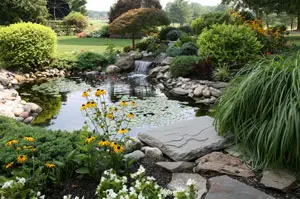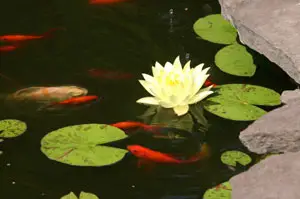Building a pond is a complex task but the individual steps in this how to build a pond guide should be well within the capabilities of most individuals who have basic landscaping and construction skills. There are few specialized tools required and this is an excellent project for those who want to add something truly elegant to their yard or garden.
The Concept

As is the case with any other complex project, building a pond starts with a solid plan. The first order of business is location. Ideally, the location should be somewhere where it is visible from the inside of the house and which has adequate sitting room around its edges. Preferably, build a pond in a location which is a bit elevated from the surrounding area to control the inflow of water from the environment.
The Layout
The easiest way to make a rough layout is to use a hose or a length of rope. Demarcate the perimeter of the in this way and work with the design until one has exactly what they want. Remember that the pond will need to be at least two feet deep if one plans to accommodate fish. For larger fish, such as koi, one should plan on a depth of at least three feet, preferably deeper.
Once the basic outline is laid out, use spray paint or chalk to make a mark along the edge of the pond. Starting about 6 inches within this mark, begin excavating!
The Interior
There need to be several levels of depth. This allows for the placement of aquatic plants and other features. If the pond is a particularly complex shape, consider making one section of the shallower than the other. If one lives in a particularly cold area, remember to dig to at least four feet in depth to prevent the water from freezing solid.
Ideally, build shelves which are about a foot and two feet below the surface. This allows for most aquatic plants to be placed within the pond.
The Liner
Every pond needs a liner. If one happens to be using an inflexible liner, such as a fiberglass liner, then the Pond's interior must conform to the dimensions and shape of that liner. One must place a layer of very compacted brick dust of one inch thickness underneath the liner, as well.
To build a pond liner from concrete it is imperative that one engage the services of a professional for installation. Laying concrete at angles and slopes is far too complex a task for the average individuals. One will also need to build footings to accommodate these liners.
Most individuals, however, choose to go with a flexible liner. This liner must conform to the dimensions of the pond. One can select the correct size using the following formulas.
Length of the Liner = Pond Length + (Pond Depth * 2) + Overlap
Depth of the Liner = Pond Width + (Pond Depth * 2) + Overlap
The length and width are measured at the widest points. The Overlap is the total extra material required for safety and to place under the edging. An overlap of 4" to 6" (this is equivalent to 2" to 3" of extra material per side of the liner) is normally sufficient. The pond liner calculator can work out the necessary liner size easily.
Butyl rubber liners are toxic to some fish. To build a pond for fish, PVC, HDPE and EPDM liners are preferable.
Before installing the liner, let it lay out in the sun for a while. This will soften the material and make it much easier to mould to the contours of the pond.
Once the liner is laid in place, use water plants or stones to make certain that it is held down to the base of the pond. The extra liner at the edges can be held in place with a bit of dirt and landscaping stone. Make sure to build a berm (a raised barrier) at the edge to keep water from the environment, which often carries pollutants, from rushing in.
The Pump & Filter
Learning how to build a pond means learning about pumps. One must ensure that the pond pump is up to the job and will provide adequate flow. Use the pond pump calculator to determine the flow rate required from the pump.
If a waterfall feature is to be added where water will be pumped outside the pond, it is a good idea to place submerged pumps on a milk crate or another porous surface to prevent the pump from completely draining the water in the event of a mishap that prevents water returning back into the pond. The fish will certainly appreciate this little attention to detail! Make certain that all the pump hoses and cords are properly-seated and ready to go. Those hoses which need to be concealed later on can be covered up with dirt or with landscaping stones.
This is also the point where any filters should be installed according to the manufacturer's directions. There are a variety of filters available such as the basket type, biological and UV filters. They all have different advantages and weaknesses, so a combination of filters will provide the best performance.

The Plants
In this stage of the pond building project, place the plants on the shelves at the edges of the pond according to their directions for care. Build shelves adequate to ones requirement before installation of the liner. Make certain that the plants are stable and that the pots are firmly in place so that they don't tip over when the water is added. The plants can also be used to conceal the pump. Plants around the edges should also be added at this time.
The Water
Now comes the moment of truth. Slowly begin adding water, making certain that the liner stays in place and that the plants aren't shifted out of their positions by the flow. This may take a considerable amount of time and it's truly surprising how much water a small pond holds. After the water is added, make any changes to the placement of the plants that one desires and test out any features such as waterfalls and fountains to make certain they're working correctly. Also test out any aerators to make sure that they function as intended. The pumps and filters should also be checked for proper function.
The Residents
Adding the fish is the crowning glory of creating a pond. Remember to dechlorinate the water before adding them so that they enter a happy and healthy home. This process is done by adding chemicals to the water. Do so exactly in accordance with the manufacturer's directions.
If this is one's first attempt at building a pond it can be a good idea to go for a pond kit, it will simplify the task for a beginner. The kit will normally also include many pond supplies required for maintenance.
Learning how to build a pond is really not as hard as most people think and is a very gratifying DIY project!

